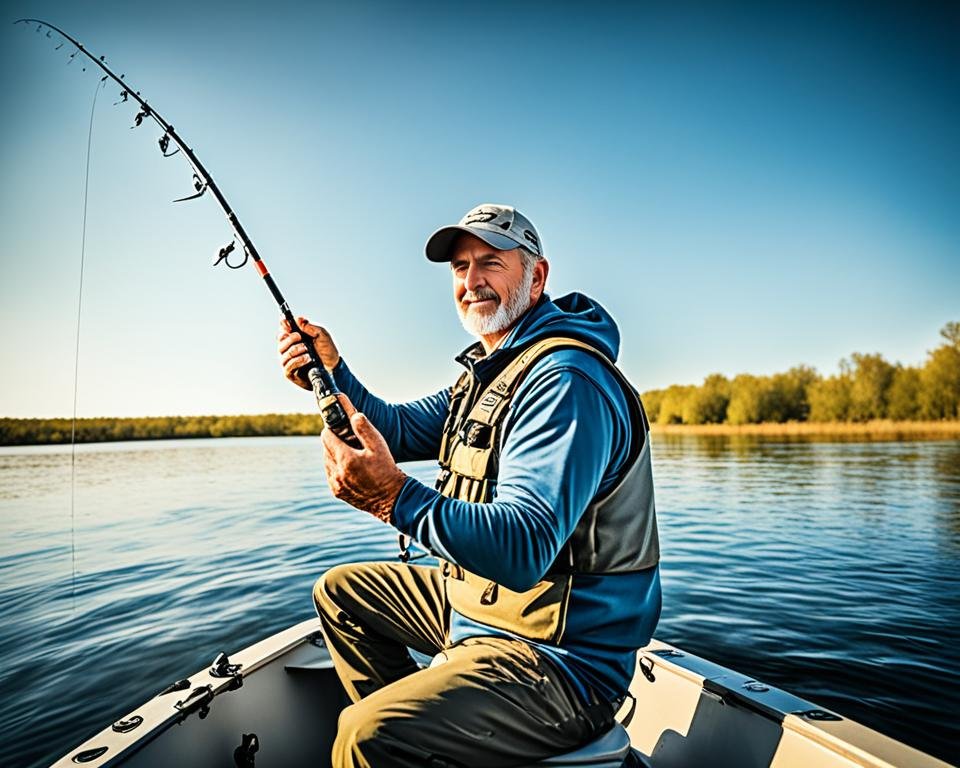Embarking on a fishing adventure alone can be a profoundly fulfilling experience. For many, the act of fishing alone offers a meditative escape, an opportunity to connect with nature, and a challenge to personal angling skills. We’ve crafted solo fishing tips that will prepare you for this unique adventure, ensuring not only a satisfying catch but also a treasure of mindful solitude.
To fish solo effectively, refining your fishing techniques is just the beginning. Along with the right angling tips and a solid understanding of the environment, the solo angler should embrace the serenity and the art of patience that comes with the territory. It’s not just about the fish; it’s about the dance of the lure and the whisper of the line — hallmarks of a true solo fishing experience.
Ensuring Safety While Fishing Alone
For the solo angler, fishing safety is not just an option, it’s a necessity. Being alone on the water increases the need for vigilance and following the best fishing practices to ensure a safe return home. Start with the basics: inform a friend or a family member about your trip details—where you’re going, what time you’re expected back, and how to reach you in an emergency.
Always wear a life jacket, regardless of how well you swim. Sudden changes in weather, unexpected water currents, or a slip could turn a peaceful fishing trip into a dangerous situation. Familiarize yourself with the forecast and water conditions, and never take unnecessary risks for the sake of a catch. Your safety gear is as crucial as your fishing gear, and both need to be in top condition.
- Wear a life jacket and safety equipment at all times.
- Inform someone about your fishing plans and expected return time.
- Monitor weather conditions closely before and during your trip.
- Select a well-known and safe fishing spot, especially if you are fishing alone for the first time.
- Carry a fully charged mobile phone and a portable charger.
- Have a well-stocked first aid kit easily accessible.
- Carry essential fishing gear that is well-maintained and suitable for the conditions.
- Understand local wildlife and be prepared to handle encounters safely.
- Stay hydrated and protect yourself from the elements – sun, wind, and cold.
- Respect water bodies and their inherent risks, tailoring your approach accordingly.
Choosing the right fishing spot is more than just about the catch—it’s about understanding the stability of the ground beneath you, the strength of currents, and the safety measures in place at that location. Similarly, the types of fishing gear you carry can make a significant difference in your safety. High-quality, reliable gear can prevent accidents and ensure you have the tools needed for a swift response in case of an emergency.
In addition to your tackle, rods, and bait, a few non-negotiable items should always be in your pack:
- A whistle or horn to signal for help.
- A knife or multi-tool for cutting lines in entanglement scenarios.
- Waterproof matches or a lighter for heat, should you get stranded.
- A torch or headlamp to ensure visibility, even as the daylight fades.
By integrating these imperative measures into your solo fishing practice, you ensure not just a productive day out but a day where safety is paramount, laying the foundation for many more successful fishing trips to come.

Mastering Solo Fishing Techniques
Acquiring the right fishing skills is crucial for the solo angler, eager to embrace the tranquility and challenge of fishing by oneself. Fishing techniques can vary widely depending on the environment and target species, but there’s a profound sense of fulfillment in successfully applying one’s knowledge to the test in the great outdoors. Below, we explore some key solo fishing tips and strategies to enhance your solo excursions and elevate your angling expertise.
For those who seek the serenity of freshwater streams, understanding the behavior of local fish populations can make a significant difference. Techniques such as fly fishing require a gentle precision and a stealthy approach, especially when fishing alone, with no one else to divert the attention of cautious trout.
- Awareness of the water’s flow and depth when wading is imperative to maintain a safe footing while focusing on the catch.
- Lure selection is another aspect where solo anglers can excel, picking the most effective patterns and colors for the specific conditions of the day.
Venturing into the open ocean demands a different set of fishing skills, where the unpredictability of the sea necessitates a robust knowledge base. Solo fishermen must be adept at reading weather patterns and water currents, making decisions that could affect not only the success of their haul but also their safety.
- Trolling is a favored technique in these conditions, allowing anglers to cover a larger area and attract game fish.
- Equipping oneself with the right gear and understanding the mechanics of solo-tackling a sizable catch are indispensable solo fishing tips for the briny deep.
The icy allure of frozen lakes presents an entirely different scenario where techniques like jigging come into play. Success in these environs requires a blend of patience, the right timing, and the acumen to select and use appropriate jigs or baits that can entice fish beneath the ice.
- Knowing how to properly set up a shelter and maintain the right temperature within it can extend your fishing time and comfort.
- Drilling multiple holes and managing lines without the help of a companion is a skill developed and refined with experience in solo fishing.
In the end, the mastery of fishing techniques and the cultivation of versatile fishing skills are what make solo fishing an endlessly rewarding activity. The deeper the understanding, the greater the sense of accomplishment when you bring in that impressive catch, all on your own. Go out there, apply these solo fishing tips, and enjoy every moment of solitude on the water.
10 TIPS FOR FISHING ALONE
Embarking on a solo fishing expedition is an adventure that requires both skill and preparation. To maximize your experience and ensure a successful outing, embrace these 10 tips for fishing alone, each one a cornerstone for any angler’s repertoire. From selecting the right gear to understanding the nuances of the natural environment, these fishing tips are your guide to the rewarding world of solo angling.
Start by researching your chosen location, assessing factors such as fish activity and weather patterns—essential angling tips to keep in mind. Every solo fishing trip should begin with a meticulous run-through of your gear, ensuring that your fishing skills are complemented by reliable equipment. When you’re on the water, mastering the art of patience is pivotal; remember, fishing is not just about the catch but also about connecting with nature. Strategic planning, combined with improvisation, allows you to adapt to changing conditions and make informed decisions when you’re out there by yourself.
Additionally, consider the importance of a well-thought-out catch management plan. When you do land a fish, having the right strategy for handling and possibly releasing your catch is a vital part of the sustainable angling practice. Lastly, relish the solitude. The self-reliance you build while fishing alone contributes to not just better fishing skills, but also a stronger appreciation for the sport. Keep these 10 tips for fishing alone in mind, and you’re sure to enjoy a fruitful adventure, full of the serenity and thrill that only solo fishing can offer.




